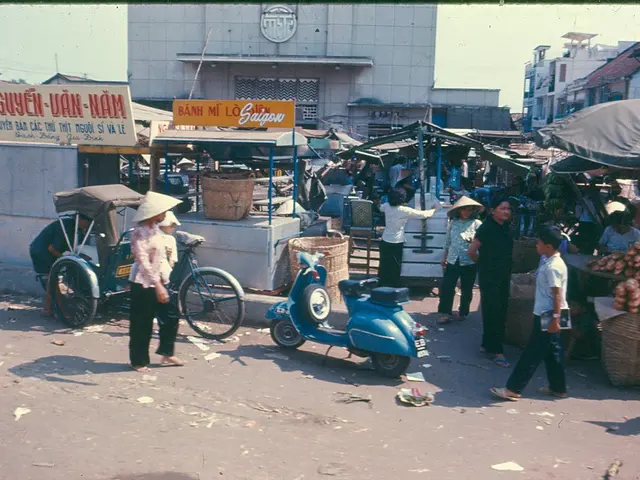Wildfires Wreaking Havoc on Oregon's Grape Harvest and Farming Sector's Financial Stability
In the heart of America, Oregon – famed for its stunning landscapes and fertile ground – stands as a pioneer in both the country's wine industry and agricultural sector. But an escalating problem looms: wildfires, increasingly frequent and intense, threaten this economic lifeblood with dire consequences. This piece delves into the intricate impacts of wildfires on Oregon's thriving wine industry and agricultural economy, offering a look into the complex challenges faced by vineyards and farms in the face of the rising blaze.
Oregon's Wine Magic
Oregon is a wine lover's Paradise, with an impressive collection of over 900 wineries and 1,300 vineyards. The state's cooler climates bless it with an exceptional Pinot Noir, a favorite among wine enthusiasts. These vintners pride themselves on environmentally friendly practices, balancing quality with care for the environment.
The Wildfire Problem
The Pacific Northwest has seen a rise in wildfires due to climate change, with both forested areas and agricultural lands at risk. Prolonged dry spells, soaring temperatures, and diminishing snowpack have set the stage for these infernos, placing Oregon's verdant agricultural lands in harm's way.
Burning Vineyards
Wildfires pose an immediate danger to vineyards, with flames obliterating grapevines and wiping out infrastructure in an instant. Even if the flames don't encroach directly, smoke exposure leads to "smoke taint," which ravages the flavor of wine, causing significant financial losses.
Smoke Taint: The Devastating Aftermath
Smoke taint becomes apparent when compounds from wildfire smoke seep into grape skins, imparting off-putting smoky or ashy flavors to the wine. This is a particular problem for delicate wines like Pinot Noir and calls for costly remediation strategies, straining the resources of winemakers.
The Monetary Fallout for Winemakers
Wildfires cause direct economic damage from razed crops and decimated infrastructure, but the long-term financial implications can be equally daunting. Expenses related to smoke taint, decreased yields, and increased insurance premiums drive significant financial pressures. Small and medium-sized wineries are most vulnerable, with the prospect of insolvency without sufficient support.
Agriculture Under Siege
Regrettably, the impact of wildfires extends beyond vineyards, affecting Oregon's broader agricultural economy. Burnt fields, water shortages, and decreased air quality wreak havoc on non-grape crops, while livestock productivity erodes. These economic losses are compounded within the agricultural sector.
Environmental Strife
Wildfires leave a profound environmental impact, with reduced soil fertility, increased erosion, and altered water cycles. Additionally, they contribute to carbon emissions, worsening climate change, and, in turn, heightening the likelihood of future fires.
Survival and Rebirth
Facing these challenges head-on, many organic and smaller wineries in Oregon have adopted imaginative strategies to weather the changing climate and wildfire risk. This includes the installation of firebreaks, experimenting with smoke-resistant grape varieties, and embracing advanced vineyard management technologies. These measures serve to strengthen resilience against future fires and limit ensuing damages.
Government and Research Support
Government backing and intervention are essential for the survival and resilience of Oregon's wine and agricultural industries. Grants, subsidies, and technical assistance play a significant role in aiding farmers and winemakers in overcoming wildfire-related setbacks. Research institutions also lend their expertise, focusing on smoke taint mitigation techniques and climate-resilient farming practices.
Insurers in the Firestorm
Insurance companies face mounting challenges while providing coverage to wineries and farms in wildfire-prone areas. Although insurance remains a vital tool for managing risk, escalating premiums and limited coverage options make it difficult for some producers to secure adequate protection against wildfire losses.
United We Stand
Community-based initiatives strengthen readiness and response to wildfire threats. Educational programs inform farmers and winemakers about the latest research and best practices for fire mitigation and recovery. Collaborative networks foster resilience by sharing resources and knowledge.
Aware Consumers and Market Forces
Consumer awareness regarding wildfires' impact on wine quality and agriculture can influence market dynamics. Transparent communication strategies help wineries to educate consumers and maintain trust, which is vital for sustaining sales even in challenging times.
The Future of Oregon's Wine Industry
The ongoing battle against wildfires will likely shape Oregon's wine industry, with innovation and adaptability being key to survival. Faced with the persisting challenges brought on by climate change and wildfires, the industry must continue evolving to ensure long-term viability, integrating sustainable practices that uphold its future health.
Farewell
The surge in wildfires poses a substantial challenge to Oregon’s wine industry and its agricultural economy. While the repercussions are grave, the collective efforts of winemakers, farmers, government agencies, and communities offer hope for resilience and recovery. By fostering innovation, teamwork, and sustainability, Oregon can preserve its cherished wine region and broader agricultural achievements, ensuring future generations can continue to enjoy the fruits of this special land.
Sincerely,
Trizzy Orozco
Enrichment Data:
The Wildfire Threat to Oregon's Wine Industry and Agricultural Economy
Wildfire Impact
- Smoke Taint: Affects wine quality, leading to financial losses for vineyards and wineries.
- Infrastructure Damage: Destruction of vineyard infrastructure such as irrigation systems and buildings results in long-term financial consequences.
- Climate Change: Rising temperatures and altered precipitation patterns aggravate wildfire risk and threaten long-term industry sustainability.
Resilience Strategies
- Smoke Taint Mitigation: Research into genetic modifications for smoke taint mitigation, vineyard monitoring, and wine production methods designed to minimize smoke taint.
- Fire Mitigation and Recovery: Innovative tactics such as installation of firebreaks, advanced fire detection systems, and sustainable land management practices aim to bolster resilience against future fires.
Support from Government, Insurance, and Research Institutions
- Government Assistance: Financial aid for affected farmers and funding for wildfire impact research.
- Insurance Coverage: Insurance companies offering coverage for smoke-related damages, while research institutions like Oregon State University contribute valuable insights into wildfire impacts and mitigation techniques.
- Research Institution Contributions: Expertise in smoke taint mitigation, adaptation strategies, and environmental research important for industry resilience.
Collaboration and Education
- Education and Awareness: Informing farmers, winemakers, and consumers about wildfire risks and mitigation strategies, improving resilience.
- Collaborative Efforts: Local communities working together to share resources and knowledge, addressing wildfire challenges collectively.
Consumer Awareness and Market Dynamics
- Wine Quality and Sales: Smoke-tainted wines can face market challenges, but consumer awareness campaigns can maintain demand for affected regions.
- Market Adaptation: Wineries innovating production methods and emphasizing the resilience of local producers to weather market fluctuations.
Future Sustainability and Resilience
- Sustainability Practices: Adopting sustainable practices like organic farming and renewable energy can enhance environmental resilience and reduce wildfire vulnerability.
- Climate Change Adaptation: Industry’s need to adapt to climate change by implementing climate-resilient practices and investing in research for long-term sustainability.
- Oregon's fertile ground houses over 900 wineries and 1,300 vineyards, specializing in Pinot Noir.
- The state's wine industry faces a looming threat due to increasing wildfires driven by climate change.
- Wildfires can obliterate grapevines and infrastructure, while smoke exposure leads to 'smoke taint' that ravages wine flavor and causes financial losses.
- Research institutions focus on smoke taint mitigation techniques and climate-resilient farming practices to aid the industry's survival.
- The agricultural sector also experiences economic losses due to burnt fields, water shortages, and decreased air quality, compounding the impact of wildfires.
- Consumer awareness regarding wildfire impacts on wine quality can influence market dynamics, with transparent communication strategies maintaining trust and sustaining sales.








